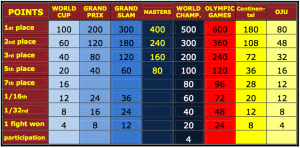The text below is the result of the pilot study that was the inspiration for my BSC. research project at University of Bath on the Beijing Olympic games Judo event. The study looks at the attack rate of players in the 2006 Commonwealth Judo tournament and their success rate. I have posted it previously on www.judocoach.com/judo but have decided to add it here as it is in keeping with the subject of this site.
Summary of the 2006 Commonwealth Judo Tournament.
Introduction:
At the 2006 Commonwealth Tournament, a study of the attacks,
scores and durations of bouts was made. Eighty-nine bouts were successfully notated. The results
have been collated and analysed and this document is a summary of the findings.
Full details on the study and methodology are being developed so to make them available to
everyone. The hope is that this will encourage others to conduct similar studies.
Statistics:
Descriptive Statistics
Total Fights 89
Total Scores 139(no penalties)
Total Attacks 1305
Total Penalties 100
Total Segments 732
Total Match Time 259Minutes 101.45Recovery time in fights
Total Actual Time 360Minutes 1.14Recovery per fight
Total Possible Contest Time 432Minutes 0.14Between segments
Fights won by Blue 47 53%
Fights won by White 42 47%
Fights won by person who attacks most 61 69%
Fights won by person who attacks least 28 31%
69 33%
21 10%
61 29%
58 28%
Total: 209
Scores per fight (AVG) 1.56
Attacks per fight (AVG) 14.66
Penalties per fight (AVG) 1.12
Segments per fight(AVG) 8.22
Of Actual time on mat 72%
Of time allocated 83%
Scores per segment 0.19
Attacks per segment 1.78
Penalties per segment 0.14
Ippons Scored
Wazaris Scored
Yokus Scored
Kokas scored
(incl Penalties)
Findings for players and coaches:
By averaging out the results of the data collected, we are able to describe an average Judo bout at
the Commonwealth Tournament level. An average fight at commonwealth level consists of the
following:
Each match is approximately four minutes long, and consists of eight “segments” of action.
Each segment of approximately 30 seconds in duration, with 14 seconds between each segment.
Within each segment we can expect 1-2 attacks only before Matte is called.
We can expect a score every 7-8 segments, this score will be Ippon 1/3rd of the time. The other
two thirds of the time it will be divided almost equally between Koka & Yoku. Wazari will be
scored infrequently (only 10% of the overall scores).
Given this description of an average match, we are able to develop coaching strategies and
training sessions to best simulate commonwealth level Judo. Sessions could be developed
following approximately the following format.
Endurance drill:
Athlete attacks at near maximal level for 30 seconds.
They then recover for 14 seconds
The above two steps are repeated 8 times.
This drill helps develop the athletes ability to give maximum effort for entire match for difficult
matches.
Tactical Drill:
Athlete fights for grip for 10 seconds
Coach calls “NOW”, and athlete must make one large attack
Athlete then continues to grip fight for 10 seconds
Coach calls “NOW”, and athlete must make one large attack
Athlete recovers for 14 seconds
Repeat above steps eight times.
This drill trains the athlete to make maximum use of the available time. Minimising risk of
passivity attacks whilst keeping energy expenditure minimal.
Active defence Drill:
Athlete is attacked constantly for 30 seconds, they must only defend.
At 10 seconds the coach shouts “NOW”, the athlete must make some form of positive attack.
At 20 seconds the coach shouts “NOW”, the athlete must make some form of positive attack.
At 30 seconds the coach shouts “NOW”, the athlete must make some form of positive attack, this
attack must be “terminal”, concluding on the floor or outside safety area.
Recover for 14 seconds
Repeat above steps eight times.
Summary
This document is a very basic analysis of a small amount of information from the 2006
Commonwealth Tournament. It is hoped that this documents shows how this form of study and
analysis can provide interesting insights which can be applied to training programme
development.
Further analysis of the data is under way and a more detailed document will follow.
The use of simple mean averages provides generalised information which provides only an
indication of general trends in the data analysed. This needs to be considered when developing
training programmes.
For example, the four minute figure mentioned in this document is a mean average of all the
fights recorded. The range of durations went from a few seconds to over twelve minutes spent on
the mat.
Similarly, the mean averaged number of segments, covers all stages in a competition. Initial
examination of the data showed a visible change in contest structure in the later stages of a
category. This included more segments, hence more attacks, but with each segment being sorter.
Your athlete may be better served by drills that followed this pattern over the average format of a
Commonwealth level Judo match
Full details of this research are available via the www.JudoCoach.com
website and/or by contact the author, Lance Wicks, directly at the email
address: lw@judocoach.com. Fellow researchers are invited to contact Lance
Wicks to source the data and digital copies of the notation forms, etc.
It is hoped that this research will act as a catalyst, encouraging further
research within the sport by researchers both with and without experience.
Kia Kaha, Kia Toa, Kia Manawanui
Be brave, Be Strong, Be Perservering
(Old New Zealand Maori Saying)
(c)2006, Lance Wicks. www.judocoach.com lw@judocoach.com

![Reblog this post [with Zemanta]](https://img.zemanta.com/reblog_e.png?x-id=1f75443a-fc30-4eac-b34c-a5a43faee74b)
